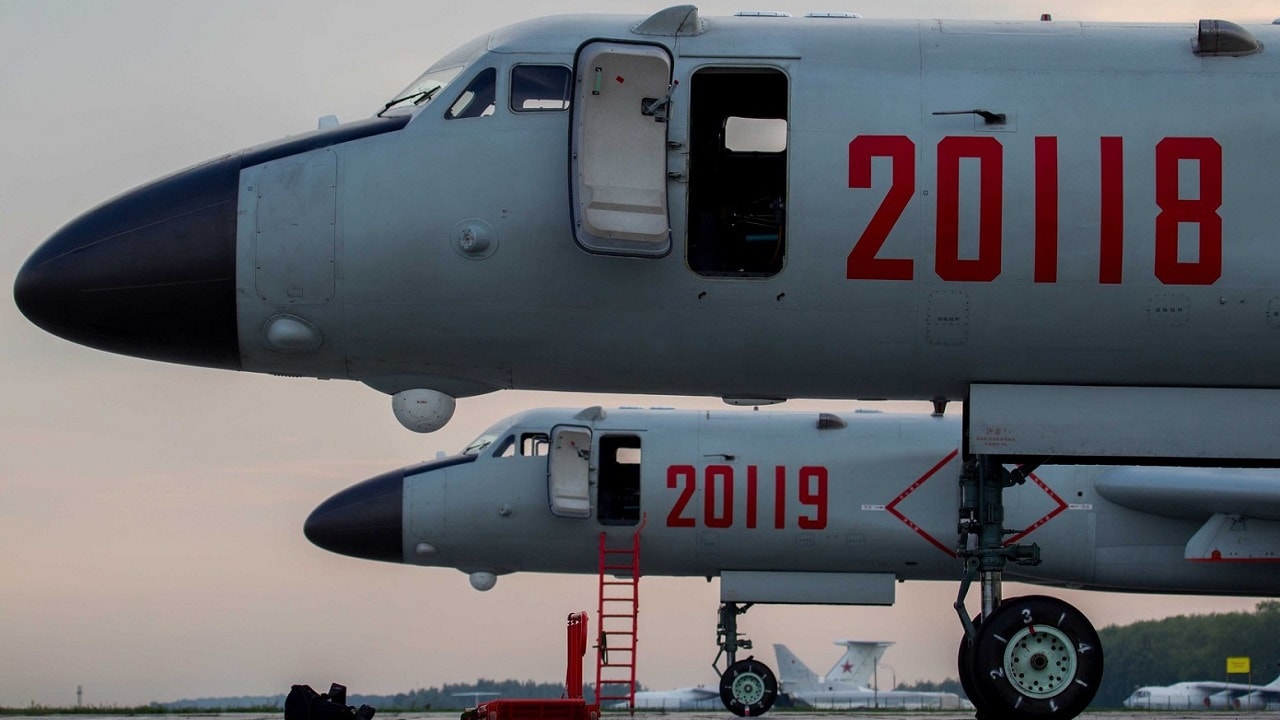Summary and Key Points: China’s H-6 bomber, a licensed adaptation of the Soviet Tu-16, remains central to Chinese strategic aviation.
-Initially produced under legal agreement rather than reverse-engineered, the H-6 evolved into numerous variants serving as bombers, tankers, recon aircraft, and maritime-attack platforms.
-Its latest version, the H-6K, is nuclear-capable, carries hypersonic KD-21 carrier-killer missiles, and features modern avionics, upgraded radar, and enhanced electronic warfare capabilities. China also intends to outfit the H-6K with the domestically produced WS-18 engine, based on the Russian D-30.
-This ongoing modernization enhances China’s long-range strike capability, presenting significant challenges to U.S. and allied forces in the Pacific region.
The H-6K Bomber, Explained
It is a long-practiced formula of China’s military aerospace sector to procure a Russian-designed platform into the service of the People’s Liberation Army (PLA), its Air Force (PLAAF), or Naval Aviation (PLANAF).
Then a team of Chinese engineers begins the process of reverse-engineering the aircraft, eventually churning out an illegal copy that is series-produced in China.
This is how the Mikoyan MiG-21, designed in the late 1950s, became the J-7. It is also how, three decades later, China’s purchase of the Sukhoi Su-27SK spawned the Shenyang J-11B series of fighter aircraft.
Although there were initially accusations that the Chinese had “stolen” the Su-27 design from Russia, the two sides ended up prevaricating on the entire issue.
Officials from the Aviation Industrial Corporation of China claimed that the J-11B aircraft were not copies because they were “only 95 per cent of the total dimensions of the original Su-27.” Sukhoi officials would not comment on whether or not their intellectual property had been stolen, and would only say that “historically a copy of an aeroplane is never going to function as well as the original.”
No Copies Here
The H-6 bomber, however, is a different story. Given it was going to be a strategically important platform, and with the Chinese efforts to reverse-engineer Russian aircraft still in their infancy, the Soviet Union and China in 1957 agreed to sign an actual, legal license-production agreement for a long-range bomber.
The aircraft that became the H-6 series of bombers with the PLAAF and PLANAF was the Tupolev Tu-16.
This was a major industrial effort on the part of the Chinese. Despite the near-pathological paranoia of the Chinese security apparatus in place at the time—including fears about Chinese workers being tainted by contact with any foreigners—a team of engineers was sent to Plant No. 22 in Kazan, Russia.
There they were trained to assemble, and later fabricate, what became known as the H-6.
In 1961, China moved the full-scale production of the aircraft from a plant in Harbin to the aircraft production association facility at Xi’an, which is where almost all bomber aircraft R&D and manufacturing has taken place ever since. The Harbin factory then focused on reverse-engineering the Ilyushin Il-28, which became the H-5 in PLAAF service.
Current Variants and Their Missions
The H-6 has for a long time been the workhorse of the PLAAF. It has turned out a long list of variants. These include conventional as well as nuclear-capable bomber platforms, aerial refueling tanker versions, reconnaissance aircraft, and maritime attack/antiship models for the PLANAF.
The latest of the PLAAF variants, the H-6K, or the “God of War,” which is now being manufactured to replace older models, is designed to serve as a long-range attack platform. While it is also nuclear-capable, the primary objective for this aircraft in any conflict in the Pacific would be to conduct long-range attacks on U.S. carrier strike groups and vital installations or communications nodes like the U.S. naval base on Guam.
Last year, the H-6K was seen carrying a load of four KD-21 carrier-killer ballistic missiles. This is an air-launched version of the CASIC CM-401 Antiship Ballistic Missile that is advertised as being capable of reaching hypersonic speeds when launched from a high altitude.
The H-6K has also been upgraded with current-generation avionics, a new radar set, a more capable Electronic Warfare module, and a modernized navigation system.
There is also a plan to refit the aircraft with a new and improved Chinese-made engine, designated the WS-18, that has been in development since the mid-2000s.
This engine is reported to be a rework of the Perm/Soloviev D-30 power plant that was the original H-6/Tu-16 engine. The D-30 series is one of the older but more reliable Russian engine designs, and it was developed in the Soviet period.
Chinese capability with aeroengines has long been a weakness of their combat-aviation sector. Five years ago, China purchased 463 of the D-30 engines to power its H-6 fleet and its Y-20 combat-cargo carrier, because it lacked the capability to build its own in adequate numbers.
However, there are reports now of a “stealthy” version of the WS-18 that has been flown on the nuclear-capable H-6 models.
About the Author and Biography
Reuben F. Johnson is a survivor of the February 2022 Russian invasion of Ukraine and is now an Expert on Foreign Military Affairs with the Fundacja im. Kazimierza Pułaskiego in Warsaw. He has been a consultant to the Pentagon, several NATO governments and the Australian government in the fields of defense technology and weapon systems design. Over the past 30 years he has resided in and reported from Russia, Ukraine, Poland, Brazil, the People’s Republic of China and Australia.

